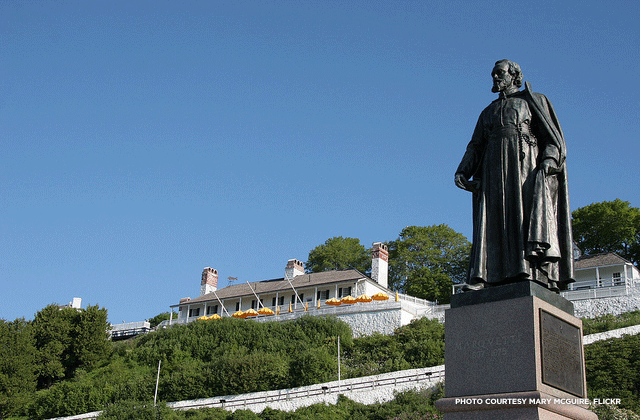
We remember the historical expedition of missionary Jacques Marquette and Louis Jolliet, a French-Canadian explorer to explore the Mississippi River. Helped by the Native Americans and avoiding Spanish conquistadors, the maps they made would help generations of pioneers and explorers
They departed from Saint Ignace, in Michigan on May 17, for a journey that would take them thousands of miles into the North American interior, confirming that it was possible to travel by water from the Great Lakes to the Gulf of Mexico and initiating some of the first white settlements in the region. Louis Joliet likely met Father Marquette and they formed an unusual partnership, born in Quebec, had been studying for the priesthood and also music, becoming a skilled harpsichordist and church organist. He received Holy Orders in 1662 but abandoned his plans to become a priest, leaving the seminary in 1667 to pursue fur trading instead. Marquette was a French Jesuit missionary sent to New France (Canada) had been dreaming of being a missionary since a child. A gifted linguist he had learned to speak fluently in six different Native American dialects and become very interested in a great river he’d heard about that the native people called "Missispi." Which meant "Great River" in the Algonquian language

The first European to make official note of the Mississippi River was Hernando de Soto, the Spanish conquistador, 130 years earlier when he had recorded its southern entrance in 1541. De Soto had named the river Rio del Espiritu Santo, but had focused his attention on the Yucatan and Nicaraguara. Later in their epic voyage, Jolliet and Marquette were the first to locate the Misisippis upper reaches, and travel most of its length. Departing from St Ignace, today on May 17, 1673, with two canoes and five other voyageurs of French-Indian ancestry, the group sailed to Green Bay. They then paddled upstream (southward) on the Fox River to the site now known as Portage, Wisconsin. There, they portaged a distance of slightly less than two miles through marsh and oak forest to the Wisconsin River.
Portaging refers to the practice of carrying water craft or cargo over land, either around an obstacle in a river, or between two bodies of water. There were many rapids and cascades and European Explorers would have learnt from the Native Americans the best routes to carry their canoes over land to avoid river obstacles. These paths where items are regularly carried between bodies of water would also be called a portage. Eventually important portages would be provided with canals with locks, and even portage railways. But the primitive portaging of Joilette and Marquette would involve carrying the vessel and its contents across the portage in multiple trips. Small canoes would be carried inverted over one's shoulders and often the centre strut would be designed in the style of a yoke to facilitate this. Marquettes group would have employed tump lines on their heads to carry loads on their backs. Europeans eventually built a trading post at that shortest convenient portage between the Great Lakes and Mississippi River basins.

The Jolliet-Marquette expedition traveled down the Mississippi to within 435 miles (700 km) of the Gulf of Mexico. They turned back north at the mouth of the Arkansas River. They where growing increasingly wary, for by this point, they had encountered natives carrying European goods and where worried about a possible hostile encounter with explorers or colonists from Spain. Returning back to the mouth of the Illinois River, which friendly natives told them was a shorter route back to the Great Lakes. Following the Illinois river upstream, they then turned up its tributary the Des Plaines River near modern-day Joliet, Illinois. They portaged their canoes and gear at the Chicago Portage thus becoming the first Europeans to winter in what would become the city of Chicago. As welcomed guests of the Illinois Confederation, the explorers were feasted on route and fed ceremonial foods such as sagamite, a native American stew. They then followed the Chicago River downstream until they reached Lake Michigan near the location of modern-day Chicago. Father Marquette stayed at the mission of St. Francis Xavier at the southern end of Green Bay, which they reached in August. Joliet returned to Quebec to relate the news of their discoveries. Marquette in particular is memorialized by various statues, monuments, and historical markers along the route. The Maps that he created would become invaluable for generations of explorers and pioneers.
.jpg)

